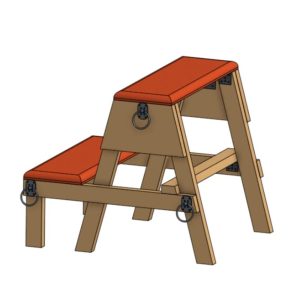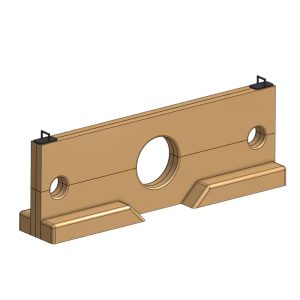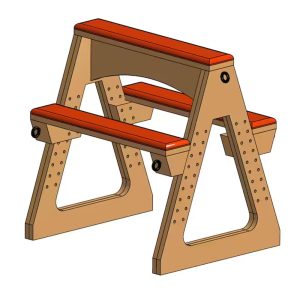BDSM Furniture Building Plans (10 Amazing Plans You Can't Miss)

BDSM is not only about the experience, it’s also about creating an environment that is both evocative and functional. Whether you’re a seasoned DIY enthusiast or new to the world of kink, crafting your own BDSM furniture can be a transformative journey. This comprehensive guide covers everything from planning and safety to detailed, step-by-step instructions for building a St. Andrew’s Cross, a Spanking Bench, and a BDSM Cage. Designed specifically for the modern millennial with a passion for fetish, kink, and creative self-expression.
Explore Our Collection of Easy to Follow BDSM Furniture Plans

Adjustable BDSM Spanking Bench Plans (Instant Download)
Ready to stop improvising spanking furniture and build something that can actually handle your scenes? These Adjustable BDSM Spanking Bench Plans show you exactly how to create a sturdy, custom bench for your play space.
You Will Learn How To:
- Understand the key features of a solid, safe spanking bench
- Cut, assemble and adjust the frame with clear, simple steps
- Add anchor points, padding and finishes that fit your style
Whats Inside: step by step build instructions, tool and materials lists, diagrams, safety tips and ideas for padding and finishes that suit your kink.
Perfect For: couples and kink fans who want real bondage furniture, built to their own size, budget and fantasies.

BDSM Table Pillory Plans (Instant Download)
Want a proper pillory without bolting hardware into your dining table forever? These BDSM Table Pillory Plans show you how to build a solid, removable pillory top that clamps to your table, then hides away when guests arrive.
You Will Learn How To:
- Design a stable pillory that sits securely on a compatible table
- Cut and assemble the frame using clear, simple steps
- Add adjustable neck and wrist openings, padding and finishing touches
Whats Inside: full DIY blueprint, cut lists, tool and materials lists, step by step diagrams, safety tips and ideas for lining, padding and dungeon worthy finishes.
Perfect For: kinky couples and creators who want serious bondage furniture, no permanent drilling and a play space that looks as intense as it feels.

BDSM Straddling Spank Bench Plans (Instant Download)
Ready to stop improvising spanking positions on beds and chairs These BDSM Straddling Spank Bench Plans show you how to build a solid, straddle friendly bench that actually fits your scenes.
You Will Learn How To:
- Design a stable straddling bench for spanking and impact play
- Cut and assemble the frame with clear, simple steps
- Add anchor points, padding and finishes that suit your style
Whats Inside: step by step build instructions, tool and materials lists, cut diagrams, safety checks and ideas for upholstery and dungeon worthy finishes.
Perfect For: kinky makers and couples who want serious spanking furniture, built to their own size, room and fantasies.
Planning and Preparation
Before picking up a saw or a drill, proper planning is essential. This phase goes beyond just choosing a design, it involves careful consideration of your available space, your technical skills, and the safety requirements inherent to BDSM furniture. A meticulously thought-out plan forms the backbone of a successful project, helping you avoid costly mistakes while ensuring that every component is purposefully designed.
Spend time sketching your ideas, measuring your space, and even creating rough 3D models using design software or simple cardboard prototypes. This hands-on preparation helps you visualize the final product, anticipate potential challenges, and refine your design for both form and function.
Safety Considerations
When building BDSM furniture, safety is paramount. Each piece of equipment is designed to support dynamic, physical activities; therefore, every joint and material must be robust and reliable. Keep these safety tips in mind:
- Structural Integrity: Reinforce every joint with quality fasteners and, where possible, metal brackets. Ensure that all load-bearing components are engineered to handle significant stress.
- High-Quality Materials: Use premium wood, metal, and upholstery materials. Lower-quality supplies may save money initially but can compromise safety and longevity.
- Accurate Measurements: Precision in measurements guarantees that each component fits perfectly. A slight miscalculation can lead to instability or uneven weight distribution.
- Proper Tool Use: Always follow safety guidelines for power tools. Equip yourself with protective gear such as goggles, gloves, and ear protection.
- Gradual Load Testing: After assembly, test your furniture gradually. Start with light pressure to ensure that every component performs as expected before using it in full play sessions.
Design and Measurements
Every DIY project starts with a vision. Your design should reflect your personal style while also meeting the practical requirements of BDSM play. Here are key factors to consider during the design phase:
- Space Considerations: Measure the area where your furniture will be placed. Ensure that the final product fits comfortably without overcrowding your room or play area.
- Functional Design: Consider the types of activities you want to facilitate. For example, the angles, heights, and supports on a spanking bench should be optimized for both comfort and accessibility.
- Aesthetic Appeal: The design should be visually striking. Whether you opt for a classic, industrial, or avant-garde look, the final product should resonate with your personal style.
- Ergonomic Factors: Ensure that your design provides adequate support and comfort to reduce the risk of strain or injury during extended sessions.
Invest time in drawing detailed blueprints and revising your plans. This initial work will pay dividends during construction, as it minimizes surprises and ensures that every piece fits perfectly into your envisioned layout.
Essential Tools and Materials for DIY BDSM Furniture
Gathering the right tools and materials is crucial for any DIY project. The following list covers the essentials needed to complete your BDSM furniture projects:
- Tools:
- Circular saw or table saw
- Power drill with various drill bits
- Screwdrivers (both flat-head and Phillips)
- Measuring tape, level, and square
- Clamps and a sturdy workbench
- Sanding machine or assorted sandpapers
- Paintbrushes or spray paint equipment
- Protective gear: goggles, gloves, and ear protection
- Materials:
- High-quality wood or plywood (for a sturdy frame)
- Metal brackets, screws, and bolts
- High-density upholstery foam
- Durable fabric or leather for covering
- Wood stain, paint, or varnish
- Adhesives and various fasteners
- Optional decorative accents for customization
Choosing quality tools and materials is not just about durability, it also affects the overall look and performance of your final product. If you’re new to woodworking or upholstery, consider seeking advice from local hardware stores or online tutorials to make informed choices.
Explore Our Collection of Easy to Follow BDSM Furniture Plans

Adjustable BDSM Spanking Bench Plans (Instant Download)
Ready to stop improvising spanking furniture and build something that can actually handle your scenes? These Adjustable BDSM Spanking Bench Plans show you exactly how to create a sturdy, custom bench for your play space.
You Will Learn How To:
- Understand the key features of a solid, safe spanking bench
- Cut, assemble and adjust the frame with clear, simple steps
- Add anchor points, padding and finishes that fit your style
Whats Inside: step by step build instructions, tool and materials lists, diagrams, safety tips and ideas for padding and finishes that suit your kink.
Perfect For: couples and kink fans who want real bondage furniture, built to their own size, budget and fantasies.

BDSM Table Pillory Plans (Instant Download)
Want a proper pillory without bolting hardware into your dining table forever? These BDSM Table Pillory Plans show you how to build a solid, removable pillory top that clamps to your table, then hides away when guests arrive.
You Will Learn How To:
- Design a stable pillory that sits securely on a compatible table
- Cut and assemble the frame using clear, simple steps
- Add adjustable neck and wrist openings, padding and finishing touches
Whats Inside: full DIY blueprint, cut lists, tool and materials lists, step by step diagrams, safety tips and ideas for lining, padding and dungeon worthy finishes.
Perfect For: kinky couples and creators who want serious bondage furniture, no permanent drilling and a play space that looks as intense as it feels.

BDSM Straddling Spank Bench Plans (Instant Download)
Ready to stop improvising spanking positions on beds and chairs These BDSM Straddling Spank Bench Plans show you how to build a solid, straddle friendly bench that actually fits your scenes.
You Will Learn How To:
- Design a stable straddling bench for spanking and impact play
- Cut and assemble the frame with clear, simple steps
- Add anchor points, padding and finishes that suit your style
Whats Inside: step by step build instructions, tool and materials lists, cut diagrams, safety checks and ideas for upholstery and dungeon worthy finishes.
Perfect For: kinky makers and couples who want serious spanking furniture, built to their own size, room and fantasies.
DIY Guide: Building Your Own St. Andrew's Cross
The St. Andrew’s Cross is an iconic piece in BDSM culture, symbolizing both restraint and freedom. Often used for various forms of impact play and bondage, this cross is a favorite among enthusiasts for its robust design and timeless appeal. Follow this step-by-step guide to construct a cross that is as safe as it is stylish.
Materials Required
- 2x4 inch lumber or high-quality plywood for the frame
- Metal corner brackets for reinforcement
- Wood screws (ranging from 1.5-inch to 3-inch lengths)
- Sandpaper or an electric sander
- Wood stain or paint in your chosen color
- Clear protective sealant
- Measuring tape, carpenter's square, and level
- Optional: Padded leather or fabric for added comfort and decorative detail
Step-by-Step Instructions for St. Andrew's Cross
- Design and Measurement: Sketch your design and decide on dimensions that suit your space. A common size for a St. Andrew’s Cross is approximately 6 feet tall by 3 feet wide, though you may adjust these dimensions based on your needs.
- Cutting the Wood: Using a circular or table saw, cut the wood into the required pieces. You will need two long vertical supports and several horizontal crossbars. Ensure that the intersections allow for sufficient overlap to maximize stability.
- Sanding and Smoothing: Sand all the wood pieces thoroughly to remove any rough edges or splinters. A smooth finish is critical for both safety and the final aesthetic.
- Assembly: Lay the vertical supports on a flat surface, and then position the horizontal crossbars. Secure each intersection with metal brackets and wood screws. Double-check that each joint is perfectly aligned using a level.
- Finishing Touches: Apply your chosen wood stain or paint to enhance the natural beauty of the wood. Once the color dries, add a layer of clear sealant to protect against wear, moisture, and frequent use.
- Optional Upholstery: If desired, add padding by affixing leather or fabric to key areas. This not only improves comfort during use but also adds a touch of luxury to your design.
- Inspection and Testing: Conduct a thorough inspection of your assembled cross. Test each joint and reinforcement by gradually applying weight and pressure to ensure that the structure is safe for use.
The St. Andrew’s Cross is more than a piece of furniture, it’s a symbol of trust, control, and artistic expression. Take your time through every step to ensure that the final product is both durable and visually appealing.
DIY Guide: Constructing a Spanking Bench
The Spanking Bench is a versatile piece designed specifically for impact play. Its design focuses on providing a secure and comfortable platform while allowing for multiple positions and angles. This guide will walk you through constructing a bench that is both sturdy and visually appealing.
Materials Required for a Spanking Bench
- Sturdy plywood or solid wood boards (minimum 3/4 inch thick)
- Metal frame supports or wooden braces
- Wood screws and bolts
- High-density foam padding
- Durable upholstery fabric or leather
- Wood stain, paint, or varnish for finishing
- Basic carpentry tools (saw, drill, screwdriver)
- Measuring tape, level, and square
Step-by-Step Instructions for the Spanking Bench
- Design Your Bench: Begin with a sketch of your desired bench. A typical spanking bench is designed with an angled surface to allow for ergonomic positioning during play. Consider dimensions that offer stability without sacrificing comfort.
- Cutting and Shaping the Base: Cut your plywood or wood boards according to your design. Ensure that the base includes a raised section for leaning and a lower section that accommodates various positions.
- Reinforcing the Structure: Attach metal supports or wooden braces at strategic points under the base to reinforce the structure. These supports are crucial for maintaining stability under dynamic loads.
- Adding Padding and Upholstery: Measure and cut high-density foam to match the contours of your bench. Secure the foam with a strong adhesive, then cover it with your choice of upholstery material. Stretch the fabric evenly and secure it using a staple gun or upholstery tacks for a clean finish.
- Finishing Touches: Apply a protective finish, such as wood stain, paint, or varnish, to all exposed wood surfaces. This not only enhances the bench’s appearance but also protects it from moisture and wear.
- Safety Testing: Before using the bench, perform a series of tests to ensure that it can support the intended activities. Check for any wobbling or weak joints and reinforce as necessary.
When constructing your spanking bench, focus on creating a piece that balances practicality with a sleek design. The right angle and proper cushioning can make all the difference in comfort and safety during use.
DIY Guide: Creating a BDSM Cage
The BDSM Cage is an ambitious project that offers versatility for various kink activities, from confinement to immersive role-play environments. This guide provides instructions on building a secure, durable cage that doesn’t compromise on style.
Materials Required for a BDSM Cage
- Sturdy wooden beams or metal pipes (depending on your design preference)
- Heavy-duty hinges and secure locking mechanisms
- Mesh panels or solid boards for the walls
- Wood screws, bolts, and reinforcement brackets
- Weatherproof paint or metal finish
- Basic tools: saw, drill, measuring tape, and level
- Optional: Padded interior elements or custom upholstery for added comfort
Step-by-Step Instructions for the BDSM Cage
- Conceptualize Your Design: Begin by outlining your cage’s design. Consider the dimensions, door placements, and wall configurations that will suit your intended activities. A well-thought-out floor plan is essential for ensuring both functionality and safety.
- Building the Frame: Cut and assemble your wooden beams or metal pipes to form the frame. Secure each joint using heavy-duty brackets and bolts. If you opt for a wooden frame, pre-drill the screw holes to prevent splitting and reinforce with additional corner brackets where needed.
- Installing the Walls: Attach mesh panels or solid boards to form the walls of the cage. Ensure that each panel is securely fastened to the frame. Extra screws or bolts at each corner add a layer of security that is critical for a structure meant for intensive use.
- Adding Doors and Locks: Install one or more doors using heavy-duty hinges. The locking mechanisms should be robust, allowing for both secure confinement and quick release in emergencies. Test each lock several times to ensure reliability.
- Finishing and Customization: Apply weatherproof paint or a specialized metal finish to protect the exterior of your cage from moisture and wear. For added comfort, consider installing padded interiors or custom upholstery in select areas.
- Inspection and Load Testing: Conduct a comprehensive inspection of the assembled cage. Apply gradual pressure and test the locking mechanisms and hinges to verify that every component meets safety standards.
Building a BDSM Cage is a challenging yet rewarding project. The final product should not only be secure and durable but also an aesthetically striking addition to your play space. Combining materials like wood and metal can yield an industrial yet warm look, tailored to your unique style.
Customization and Finishing Touches
Once the basic structure of your BDSM furniture is complete, the next phase is to make it uniquely yours. Customization goes beyond aesthetics, it’s about tailoring every detail to enhance functionality, comfort, and visual appeal.
Upholstery and Padding Options
High-quality upholstery and padding are essential for creating furniture that is both safe and comfortable. Consider the following options:
- Leather vs. Fabric: Leather provides a classic, luxurious feel and is relatively easy to clean. Durable fabrics offer versatility with colors and textures, allowing you to match your decor.
- High-Density Foam: Using high-density foam ensures that your piece maintains its shape and offers firm support even during extended sessions.
- Modular Designs: Removable covers or modular padding systems are practical for maintenance and allow you to update your design without reconstructing the entire piece.
- Secure Attachment: Use industrial adhesives or reinforced stitching to ensure that the upholstery remains securely in place over time.
Decorative Accents and Functional Additions
Personalizing your BDSM furniture can transform it into a signature statement piece. Consider adding these enhancements:
- Carved Wood Details: Incorporate intricate carvings or engraved motifs that echo themes from BDSM and fetish art.
- Integrated Restraints: Seamlessly include built-in cuffs, shackles, or anchor points that complement the overall design while remaining functional.
- Ambient Lighting: Soft LED lighting integrated into the structure can set the mood and highlight the craftsmanship of your piece.
- Contrasting Finishes: Experiment with a mix of matte and gloss finishes to create a visually dynamic surface that draws the eye.
Tips for Maintaining and Upgrading Your DIY BDSM Furniture
Keeping your custom-built furniture in peak condition is as important as the construction process itself. Regular maintenance not only extends the lifespan of your pieces but also ensures continued safety and performance. Consider these maintenance tips:
- Regular Inspections: Frequently check for any loose screws, worn upholstery, or weakened joints. Addressing small issues early can prevent major repairs later.
- Cleaning and Care: Use cleaning products that are compatible with your materials. Leather may benefit from specialized conditioners, while wooden surfaces might require periodic re-staining or sealing.
- Component Upgrades: As your needs evolve, don’t hesitate to upgrade parts of your furniture. Whether it’s installing more secure locking mechanisms or refreshing the padding, these improvements can enhance both functionality and safety.
- Documentation: Keep detailed records of your projects, including design sketches, materials used, and any modifications made. This documentation is invaluable for future upgrades or repairs.
- Safety Rechecks: After any upgrade or repair, retest the equipment to ensure it maintains the structural integrity required for safe use.
Maintaining your DIY creations is an ongoing process that reflects the care and passion you’ve invested in them. Regular upkeep not only preserves their aesthetic appeal but also provides peace of mind during use.
Explore Our Collection of Easy to Follow BDSM Furniture Plans

Adjustable BDSM Spanking Bench Plans (Instant Download)
Ready to stop improvising spanking furniture and build something that can actually handle your scenes? These Adjustable BDSM Spanking Bench Plans show you exactly how to create a sturdy, custom bench for your play space.
You Will Learn How To:
- Understand the key features of a solid, safe spanking bench
- Cut, assemble and adjust the frame with clear, simple steps
- Add anchor points, padding and finishes that fit your style
Whats Inside: step by step build instructions, tool and materials lists, diagrams, safety tips and ideas for padding and finishes that suit your kink.
Perfect For: couples and kink fans who want real bondage furniture, built to their own size, budget and fantasies.

BDSM Table Pillory Plans (Instant Download)
Want a proper pillory without bolting hardware into your dining table forever? These BDSM Table Pillory Plans show you how to build a solid, removable pillory top that clamps to your table, then hides away when guests arrive.
You Will Learn How To:
- Design a stable pillory that sits securely on a compatible table
- Cut and assemble the frame using clear, simple steps
- Add adjustable neck and wrist openings, padding and finishing touches
Whats Inside: full DIY blueprint, cut lists, tool and materials lists, step by step diagrams, safety tips and ideas for lining, padding and dungeon worthy finishes.
Perfect For: kinky couples and creators who want serious bondage furniture, no permanent drilling and a play space that looks as intense as it feels.

BDSM Straddling Spank Bench Plans (Instant Download)
Ready to stop improvising spanking positions on beds and chairs These BDSM Straddling Spank Bench Plans show you how to build a solid, straddle friendly bench that actually fits your scenes.
You Will Learn How To:
- Design a stable straddling bench for spanking and impact play
- Cut and assemble the frame with clear, simple steps
- Add anchor points, padding and finishes that suit your style
Whats Inside: step by step build instructions, tool and materials lists, cut diagrams, safety checks and ideas for upholstery and dungeon worthy finishes.
Perfect For: kinky makers and couples who want serious spanking furniture, built to their own size, room and fantasies.
Download Free BDSM Furniture Building Plans
St Andrews Cross Furniture Plans
Spanking Chest Furniture Plans
Frequently Asked Questions about BDSM Furniture Building Plans
What are the most important safety considerations?
Safety starts with using high-quality materials and following precise measurements. Reinforce all load-bearing joints with brackets and additional fasteners, and always test your construction gradually. A well-planned design minimizes risks during intense activities.
How do I choose the right materials?
Your choice of materials should balance durability, aesthetics, and comfort. Premium wood and metal hardware offer long-lasting strength, while upholstery materials such as leather or heavy-duty fabric provide both comfort and visual appeal. Consider environmental factors and the intended use when selecting finishes and adhesives.
Can I customize the design to fit my space?
Absolutely. DIY projects allow you to tailor every aspect, from dimensions and angles to finishes and decorative details. Adjust your design to ensure that the furniture integrates seamlessly with your play area and meets your functional needs.
How long does it typically take to build these pieces?
The time required depends on the complexity of your design and your experience level. A straightforward St. Andrew’s Cross might be completed over a weekend, while more intricate projects like a BDSM Cage or a fully upholstered Spanking Bench could take several weekends. Always plan for extra time for finishing touches and safety inspections.
Are there any risks involved in DIY BDSM furniture building?
Every DIY project carries some risk, but these can be minimized by adhering to strict safety protocols, using high-quality materials, and carefully testing your work. If you’re ever in doubt, seek advice from experienced builders or professionals.
Is advanced carpentry expertise required?
Not necessarily. Many of these designs can be adapted for beginners, and numerous online resources are available to help you through each step. Start with simpler projects to build your confidence before progressing to more complex builds.
What should I do if I encounter a structural problem?
If you notice a structural issue, such as misaligned joints or instability, pause your work and review your design. It may be necessary to add extra supports or remeasure your components. Safety should always come first.
Where can I find additional resources and support?
Online communities, DIY blogs, and video tutorials are excellent sources of information and support. Engaging with others who share your passion can provide you with creative ideas and practical advice.
Resources and Further Reading
For those eager to dive even deeper into the world of DIY BDSM furniture and related projects, the following resources are highly recommended:
- Online Communities: Join forums and social media groups dedicated to BDSM and DIY projects. These platforms offer real-world advice, project inspiration, and a supportive network of like-minded individuals.
- Tutorial Videos: YouTube and other video-sharing platforms host a variety of step-by-step guides on woodworking, upholstery, and specialized DIY projects tailored for BDSM settings.
- DIY Blogs and Websites: Explore blogs that focus on modern carpentry, furniture design, and fetish art. These sites provide detailed tutorials, design ideas, and troubleshooting tips.
- Workshops and Courses: Consider enrolling in local or online courses in carpentry, metalwork, or upholstery to refine your skills and gain hands-on experience.
- Books and Magazines: Publications on home improvement and specialized DIY projects can offer advanced techniques and inspire creative approaches to your builds.
Expanding your knowledge through these resources will not only enhance your current projects but also inspire new ideas for future creations. Embrace the continuous learning process that comes with DIY craftsmanship, and let each project be a stepping stone to even greater innovation.
Inspiration and Next Steps
Embarking on a DIY BDSM furniture project is an exciting journey that allows you to express your individuality while enhancing your play space. With careful planning, quality materials, and a focus on safety, you can create pieces that are both functional and visually compelling. Whether you’re drawn to the timeless appeal of a St. Andrew’s Cross, the versatile design of a Spanking Bench, or the bold statement of a BDSM Cage, each project is an opportunity to push creative boundaries and develop your skills.
Every successful DIY project is built on a foundation of research, patience, and experimentation. As you gain experience, you’ll discover that your designs evolve, integrating advanced techniques, innovative materials, and personal touches that set your creations apart. Use this guide as a launching pad for your next project, and don’t be afraid to experiment with new ideas and configurations.
Let your play space reflect your unique style and passion. Mix textures, colors, and finishes to craft an environment that is as stimulating as it is safe. With every cut, screw, and brushstroke, you’re not just building furniture, you’re building a space that celebrates creativity, empowerment, and the art of BDSM.
Embrace the challenges and celebrate the successes. Your DIY journey in BDSM furniture building is a testament to your creativity, technical skill, and dedication to crafting an environment that is uniquely yours. Now, it’s time to gather your tools, review your plans, and start building your vision, one measured cut at a time.
Explore Our Collection of Easy to Follow BDSM Furniture Plans

Adjustable BDSM Spanking Bench Plans (Instant Download)
Ready to stop improvising spanking furniture and build something that can actually handle your scenes? These Adjustable BDSM Spanking Bench Plans show you exactly how to create a sturdy, custom bench for your play space.
You Will Learn How To:
- Understand the key features of a solid, safe spanking bench
- Cut, assemble and adjust the frame with clear, simple steps
- Add anchor points, padding and finishes that fit your style
Whats Inside: step by step build instructions, tool and materials lists, diagrams, safety tips and ideas for padding and finishes that suit your kink.
Perfect For: couples and kink fans who want real bondage furniture, built to their own size, budget and fantasies.

BDSM Table Pillory Plans (Instant Download)
Want a proper pillory without bolting hardware into your dining table forever? These BDSM Table Pillory Plans show you how to build a solid, removable pillory top that clamps to your table, then hides away when guests arrive.
You Will Learn How To:
- Design a stable pillory that sits securely on a compatible table
- Cut and assemble the frame using clear, simple steps
- Add adjustable neck and wrist openings, padding and finishing touches
Whats Inside: full DIY blueprint, cut lists, tool and materials lists, step by step diagrams, safety tips and ideas for lining, padding and dungeon worthy finishes.
Perfect For: kinky couples and creators who want serious bondage furniture, no permanent drilling and a play space that looks as intense as it feels.

BDSM Straddling Spank Bench Plans (Instant Download)
Ready to stop improvising spanking positions on beds and chairs These BDSM Straddling Spank Bench Plans show you how to build a solid, straddle friendly bench that actually fits your scenes.
You Will Learn How To:
- Design a stable straddling bench for spanking and impact play
- Cut and assemble the frame with clear, simple steps
- Add anchor points, padding and finishes that suit your style
Whats Inside: step by step build instructions, tool and materials lists, cut diagrams, safety checks and ideas for upholstery and dungeon worthy finishes.
Perfect For: kinky makers and couples who want serious spanking furniture, built to their own size, room and fantasies.
Oh and... If you're looking for something different, check out the BDSM furniture created by Sensory London. The restore antiques and turn them into beautiful BDSM furniture masterpieces.

 Fuck Each Other Not The Planet Unisex
Fuck Each Other Not The Planet Unisex Wear My Kink
Wear My Kink